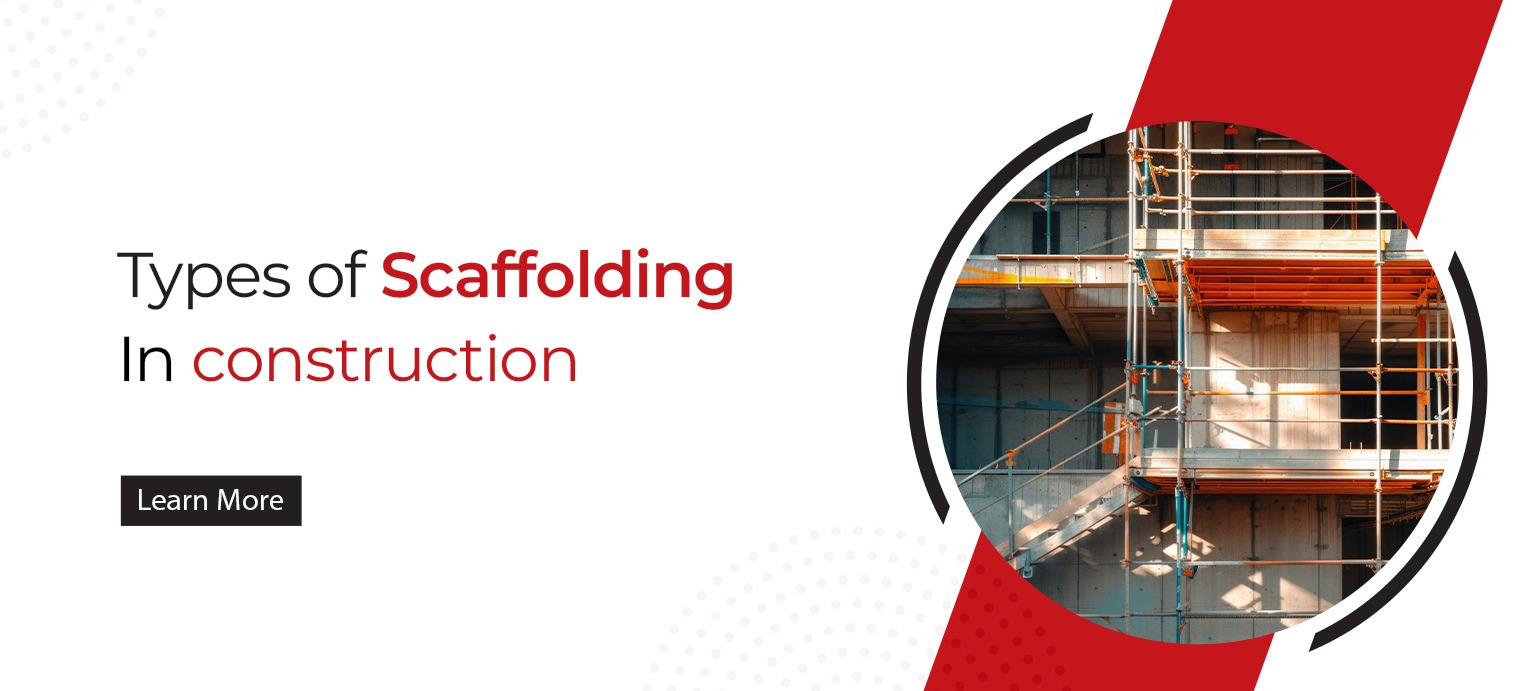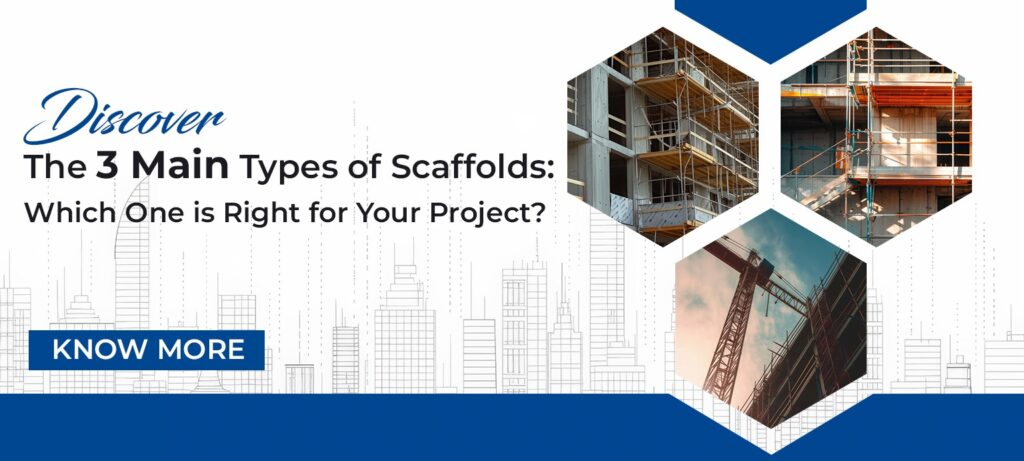In the construction industry, scaffolding is an indispensable component that ensures safety and efficiency across diverse projects. Whether you’re working on a high-rise building, a residential property, or an industrial structure, understanding the various types of scaffolding is crucial for construction professionals.
This guide delves into the different types of scaffolding systems, their applications, and benefits, providing you with the knowledge needed to choose the right scaffolding for your next project.
Types of Scaffolding:
1. Supported Scaffolding
Supported scaffolding is the most common type and is built from the ground up. It consists of various components such as tubes or frames, planks, and couplers. This system is highly versatile and can be used in a variety of construction projects.
Applications:
- Bricklaying
- Plastering
- Painting
- Masonry work
2. Suspended Scaffolding
Suspended scaffolding is hung from the roof or an elevated structure and can be lowered or raised as needed. This type is frequently used for tasks that require access to the upper levels of a structure, such as window cleaning or exterior painting.
Applications:
- High-rise window cleaning
- Exterior painting
- Building maintenance
3. Rolling Scaffolding:
Rolling scaffolding is similar to supported scaffolding but features wheels or casters for mobility. This type is ideal for projects that require frequent movement, such as electrical or drywall work.
Applications:
- Drywall installation
- Electrical work
- Indoor maintenance
4. Aerial Lifts:
Aerial lifts include equipment such as scissor lifts and boom lifts. These are mobile, elevated work platforms that can be moved and positioned with ease. They are particularly useful for tasks that require reaching high places quickly.
Applications:
- HVAC installation
- Tree trimming
- Signage installation
5. Single Pole Scaffolding:
Single pole scaffolding consists of a single row of poles supported against a structure with the help of ledgers, putlogs, and other components. It is often used for minor repair work.
Applications:
- Minor facade repairs
- Painting
- Plastering
6. Double Pole (Independent) Scaffolding:
Double pole scaffolding, also known as independent scaffolding, features two rows of poles, providing additional support and stability. This type is commonly used in stone masonry projects where the wall is not capable of supporting putlogs.
Applications:
- Stone masonry
- Roofing
- Carpentry
7. Cantilever (Needle) Scaffolding:
Cantilever scaffolding is supported by needles (cantilevers) projecting out from the structure. This type is used when the ground space is obstructed or when the upper part of the building is under construction.
Applications:
- Bridges
- Overpasses
- Areas with ground obstructions
8. Trestle Scaffolding:
Trestle scaffolding is supported on tripods or movable ladders and is commonly used for indoor work, such as painting or light maintenance tasks.
Applications:
- Indoor painting
- Light maintenance
- Ceiling work
9. Steel Scaffolding:
Steel scaffolding is made from steel tubes and is known for its durability and strength. It is highly versatile and can be used in various construction projects, especially those requiring a high load-bearing capacity.
Applications:
- High-rise buildings
- Industrial structures
- Heavy construction tasks
10. Patented Scaffolding
Patented scaffolding is made using specially designed, pre-fabricated components that come with unique locking mechanisms. This type is typically made from steel and provides quick and easy assembly and disassembly.
Applications:
- Temporary stages
- Event installations
- Short-term construction tasks
Advantages and Disadvantages of Each Type:
Supported Scaffolding
Advantages:
- Versatile and easy to construct
- Suitable for various applications
Disadvantages:
- Requires solid ground support
- Can be time-consuming to assemble
Suspended Scaffolding
Advantages:
- Ideal for high-rise buildings
- Easily adjustable
Disadvantages:
- Requires specialized equipment
- May not be suitable for heavy loads
Rolling Scaffolding
Advantages:
- Highly mobile
- Convenient for indoor use
Disadvantages:
- Limited height
- Requires flat surfaces
Aerial Lifts
Advantages:
- Quick setup and mobility
- Can reach significant heights
Disadvantages:
- Expensive
- Requires operator training
Single Pole Scaffolding
Advantages:
- Simple to construct
- Cost-effective
Disadvantages:
- Limited stability
- Not suitable for heavy-duty tasks
Double Pole (Independent) Scaffolding
Advantages:
- Provides extra stability
- Suitable for heavier tasks
Disadvantages:
- Requires more materials
- More complex to assemble
Cantilever (Needle) Scaffolding
Advantages:
- Ideal for obstructed ground areas
- Provides flexibility
Disadvantages:
- Complex setup
- Requires structural support
Trestle Scaffolding
Advantages:
- Portable and easy to set up
- Ideal for indoor work
Disadvantages:
- Limited height and load capacity
- Not suitable for outdoor use
Steel Scaffolding
Advantages:
- Durable and strong
- Suitable for heavy loads
Disadvantages:
- Heavier and less portable
- More expensive
Patented Scaffolding
Advantages:
- Quick assembly and disassembly
- Prefabricated components
Disadvantages:
- Higher cost
- Requires specific components
Regulations and Best Practices
When using scaffolding in construction, adhering to regulations and best practices is essential to ensure safety and compliance. The Occupational Safety and Health Administration (OSHA) provides comprehensive guidelines to follow.
Key Regulations:
- Ensure proper training for all workers using scaffolding.
- Regularly inspect scaffolding for damage and wear.
- Use guardrails, midrails, and toeboards to prevent falls.
- Secure platforms and planks to prevent movement.
- Maintain a safe load capacity for scaffolding structures.
Best Practices:
- Conduct thorough site assessments before scaffolding installation.
- Use appropriate personal protective equipment (PPE).
- Implement a scaffold tagging system for inspection and maintenance records.
- Keep scaffolding free of debris and obstructions.
- Provide clear signage and barricades around scaffolding areas.
Conclusion
Scaffolding is a cornerstone of construction, enabling professionals to carry out tasks efficiently and safely at heights. By understanding the different types of scaffolding and their applications, construction professionals can make informed decisions that enhance project outcomes. Remember to always adhere to safety regulations and best practices to ensure a secure working environment.
If you’re looking to stay updated on the latest construction trends and insights, be sure to follow our blog and join our professional community. For more in-depth information on scaffolding and other construction topics, sign up for our newsletter today.
By implementing the right scaffolding systems and prioritizing safety, you can drive your construction projects to new heights of success.



